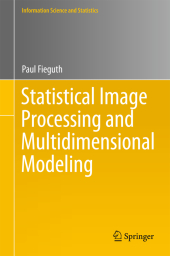 Neuerscheinungen 2012Stand: 2020-01-07 |
Schnellsuche
ISBN/Stichwort/Autor
|
Herderstraße 10
10625 Berlin
Tel.: 030 315 714 16
Fax 030 315 714 14
info@buchspektrum.de |

Paul Fieguth
Statistical Image Processing and Multidimensional Modeling
Repr. d. Ausg. v. 2011. 2012. xxii, 454 S. XXII, 454 p. 235 mm
Verlag/Jahr: SPRINGER, BERLIN 2012
ISBN: 1-461-42705-3 (1461427053)
Neue ISBN: 978-1-461-42705-6 (9781461427056)
Preis und Lieferzeit: Bitte klicken
This book presents methods for solving multidimensional statistical problems. Covering both theory and applications, it emphasizes inverse problems, multidimensional modeling, random fields and hierarchical methods.
Images are all around us! The proliferation of low-cost, high-quality imaging devices has led to an explosion in acquired images. When these images are acquired from a microscope, telescope, satellite, or medical imaging device, there is a statistical image processing task: the inference of something - an artery, a road, a DNA marker, an oil spill - from imagery, possibly noisy, blurry, or incomplete.
A great many textbooks have been written on image processing. However this book does not so much focus on images , per se, but rather on spatial data sets, with one or more measurements taken over a two or higher dimensional space, and to which standard image-processing algorithms may not apply.
There are many important data analysis methods developed in this text for such statistical image problems. Examples abound throughout remote sensing (satellite data mapping, data assimilation, climate-change studies, land use), medical imaging (organ segmentation, anomaly detection), computer vision (image classification, segmentation), and other 2D/3D problems (biological imaging, porous media).
The goal, then, of this text is to address methods for solving multidimensional statistical problems. The text strikes a balance between mathematics and theory on the one hand, versus applications and algorithms on the other, by deliberately developing the basic theory (Part I), the mathematical modeling (Part II), and the algorithmic and numerical methods (Part III) of solving a given problem. The particular emphases of the book include inverse problems, multidimensional modeling, random fields, and hierarchical methods.
Introduction.- Inverse problems.- Static estimation and sampling.- Dynamic estimation and sampling.- multidimensional modelling.- Markov random fields.- Hidden markov models.- Changes of basis.- Linear systems estimation.- Kalman filtering and domain decomposition.- Sampling and monte carlo methods.
Paul Fieguth is a professor in Systems Design Engineering at the University of Waterloo in Ontario, Canada. He has longstanding research interests in statistical signal and image processing, hierarchical algorithms, data fusion, and the interdisciplinary applications of such methods, particularly to problems in medical imaging, remote sensing, and scientific imaging.


